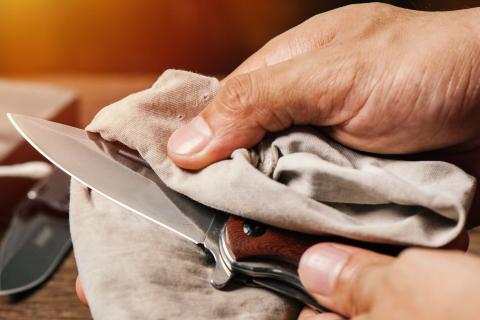
Caring for a Pocket Knife is Simple, But Important
A quality pocket knife like a Case knife or Buck knife is meant to last for decades, even generations. But if you want to pass a favorite knife along when you become a Gramps or Grammy, it will require some tender loving care.
 |
| Case Yellow Handle Pocket Knife - Medium Stockman |
Whether your view of a pocket knife is as an heirloom passed along from a grandparent to child to grandchild or simply as a tool that you carry every day – the knife will last longer and serve you better if you know how to care for a pocket knife. Best of all, it’s really not that difficult.
 |
| Buck Trio Pocket Knife |
Caring for a pocket knife breaks down into three categories of care:
- Prevent Rust
- Lubricate
- Sharpen
Protect Your Pocket Knife From Rust
 |
| With proper care, even a hard working pocket knife can be passed down through generations. |
The greatest enemy of any knife is rust and corrosion. Given the right … or wrong … conditions, even stainless steel can rust or at least discolor. Once a blade is corroded, there’s never really any good way to completely hide that scar, so you must prevent rust from happening in the first place.
The best way to prevent rust is to keep the blade and all ferrous metal parts coated with a very light film of oil. Even if you live and carry your knife in a marine environment where salt is present in the humid air, conscientious oiling will prevent corrosion. If your knife were to ever come in contact directly with salt water, be sure to rinse it thoroughly under running fresh water, dry it, and recoat it with oil. Something like 3-In-1 oil or a good gun oil works great for this purpose.
To oil the blade of a pocket knife, simply put three or four drops of oil on one side of the blade and wipe it off with an oily rag. Take a trick from preventing rust on firearms, and keep a small, soft rag well oiled and sealed in a Ziploc bag. Then you can use that cloth to wipe down any metal surfaces you want to keep corrosion free.
 |
| Case Large Leather Knife Sheath |
Another big step in preventing corrosion of ferrous metals and discoloring nonferrous metals is never storing a knife for long stretches in a knife sheath. Even if your EDC knife is a folder you carry in a sheath on your belt, it should come out of the sheath when you’re not carrying it. Leather sheaths hold moisture and collect grit to which you do not want to expose your knife for extended periods. Synthetic sheaths are better about venting moisture, but it’s still not wise to store a knife in the sheath for prolonged periods.
Lubricate Your Pocket Knife Regularly
To keep a folding knife operating smoothly and prevent unnecessary wear, it’s also important to keep the moving parts lubricated. You can use the same oil you used to coat the blade, but a thicker grease will last longer. Even better is a dry lubricant like Remington Rem-DriLube. It won’t create oil spots in your pants pockets.
 |
| Remington Rem-DriLube Dry Aerosol Spray Lubricant |
Whatever you choose, it’s important the lubricant container offers a method to place the lube precisely where you want it. You don’t want to make a mess by hosing down your whole pocket knife.
On a locking liner knife, aim the applicator directly at the pivot area. Open and close a few times. If it’s smooth, you’re done. If it sticks or grabs, give it another shot.
For lock back knives and slip joint knives, open the blade or blades perpendicular to the handle and apply the lube into the notch at the tang. Check for smooth operation.
Simple - right?
Sharpen Your Pocket Knife Regularly
When it comes to knives, nearly all we ever hear about are new ways to sharpen knives. You know what? However you decide to go about putting a shaving sharp edge on your everyday carry pocket knife is a good one. Some methods may be more aggressive than necessary, but sharp is sharp. Unless you’re hooked on tradition, today there’s no need to spend hours and hours learning to use a whetstone and razor strop to sharpen a knife. Kits and sharpeners of all types and in all price ranges will help you keep your knives sharp if you’ll just use them.
![]() Tip: There is such a wide range of knife sharpeners and sharpening systems available to sportsmen today from the simplest hones for touch ups in the field to powered grinders that sharpen every kind of knife and tool in your house and workshop. Bass Pro Shops offers knife sharpening systems in every category.
Tip: There is such a wide range of knife sharpeners and sharpening systems available to sportsmen today from the simplest hones for touch ups in the field to powered grinders that sharpen every kind of knife and tool in your house and workshop. Bass Pro Shops offers knife sharpening systems in every category.
Whichever method you choose, sharpen your pocket knife regularly – especially after extended or rugged use. Often your knife won’t need much more than a touch-up or stropping, so make it part of your care routine.
- 4139 views


